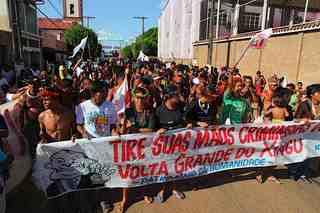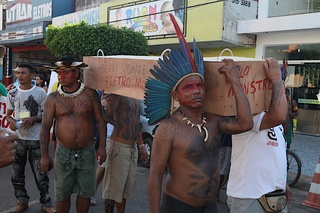Report No. 926:
The event, a milestone in the fight against construction of major projects in the Amazon region, closes with the participation of indigenous and traditional communities coming from different regions of the country. "The Xingu is a stronghold of centuries-old cultures, a stronghold of salvation to a diversity of peoples and an entire diversity of animals that is unique and only found here."
By Cleymenne Cerqueira
From Altamira, Pará, Brazil
Following four days of discussions, debates and presentations, the encampment In Defense of the Xingu, against Belo Monte draws to a close. The event, organized in Orla do Cais, Porto de Altamira, Pará began on Monday (Aug. 9) with the arrival of several of the nation’s indigenous delegations, representatives of riverine communities, agriculturalists, fishermen and social movements, including international organizations.
Diversity Stronghold
The meeting engaged discussion with several participating experts on impacts generated by large federal government projects such as dams, roads and mining. Panelists included professors from the Federal University of Pará (UFPA), members of organizations fighting to guarantee the rights of indigenous and riverine peoples. All were emphatic in pointing out the damage that would be generated by the Belo Monte hydroelectric plant.
The government mega-project will impact not only indigenous lands, but rural properties and dryi part of the Xingu River, from which many families derive their livelihoods and income; it will increase water temperatures, which makes the survival of several fish species impossible; it will cause massive deforestation and extinction of animals and plants found only in this region.
"The Xingu is stronghold of centuries-old cultures, a stronghold of salvation to a diversity of peoples and an entire diversity of animals that is unique and only found here", states UFPA researcher, Dr. Janice Muriel Cunha.
According to Dr. Cunha, the people must decide if what they want is the form of development proposed by the Brazilian government – a distinctly European model – or a clean and just development. "The development model adopted by Europe destroyed circa 99.2% of natural vegetation and environmental resources on that continent. Is this what we want?”, Janice inquired.
For researcher Rodolfo, also from UFPA, Belo Monte is just an electionist adventure, because Brazil does not need this project to develop and be happy. "It is a maneuver by [presidential candidate] Dilma Roussef to promote herself and other ‘rogues’ of the Brazilian energy system."
Janice believes that Belo Monte is just one of the struggles that the Brazilian people have to face. "This dam project is only one more that we scientists, riverine, indigenous and urban populations must learn to combat. Like these, many others will come, all unviable in social, economic, environmental and cultural terms."
Where will the people of the Xingu go? 
This is the question posed by the population of Altamira, which remains unanswered. "What will be done with the approximately 30,000 persons who will be affected by the construction of the hydroelectric dam and plant? Where will they go, where and how will they live?" Asks Dom Erwin Kräutler, bishop of the Xingu Prelature and president of the Indigenous Missionary Council (CIMI).
Dom Erwin has accompanied the struggles against Belo Monte since 1975, the period of the dictatorial regime in Brazil, when the government submitted a proposal to construct six dams on the Xingu river and one on the Iriri river. After political and social pressure, the people and social movements succeeded in barring the project, which they believed to be abandoned, forgotten.
However, the Lula administration surprised the Brazilian population by again introducing the same project, formerly called Kararaô. "Only the name was changed, but the intention remains the same: to destroy the environment and the peoples of the Xingu. It was a great surprise to us that this government in particular, in whom we always believed, disinterred this project and brought it in office again", he declared.
For the bishop, the government lies when it says that only this dam will be built in the region, because after this project is ready, it will always say that in order to generate the energy necessary for the population of the country, more and more hydroelectric dams will have to be built.
Key questions
In addition to their daily questioning of where people of the Xingu will go and what will happen with the environment of this region, other concerns plague the thoughts of Altamira inhabitants. Where will families get their food if not from the rivers and forests? How are those communities going to live without water when the flow of the river is reduced?
”These people who are accustomed to living through the labor of their own hands, hunting, fishing, agriculture, how will they live in good homes with furniture, electricity, piped water, household appliances, but without their primary source of survival? How will they live? How will they raise their children and grandchildren?", asks Dom Erwin.
Even now, the population of Altamira does not know the actual size of the reservoir. Dimensions of the work are changed on a daily basis and people are not even informed. For Dom Erwin and the numerous experts who conducted feasibility studies on the enterprise, the reservoir will be a putrid, dead lake, a breeding ground for pests and endemic diseases on the banks of which many families will remain, left to their own devices.
"The same government that banned capture and marketing of ornamental fish in the region released the Belo Monte project. What a contradiction! Income generation and survival via the waters of the old Xingu are prohibited, but the extinction of animals, invasion and flooding of rural lands, the expulsion of diverse families in the region, misery and hunger, violence and disease are not", challenged Dr. Cunha.
The project, an example of many other large scale projects in Brazil, will bring innumerable workers and families chasing the dream of an Eldorado, augmenting the Altamira population, today circa 100,000 people, by absurd numbers. Regional conditions are inadequate to receive them, thereby generating conflict, violence and problems of basic healthcare and education, among others.
Popular representation 
In addition to the Juruna, Xipaya, Arara, Kuruaia and Xicrin peoples of the Altamira region, participating in the event are leaders of the
Guajajara, Gavião, Krikati, Awá Guajá, Kayapó, Tembé, Aikeora, Suruí, Xavante, Karintiana, Puruborá, Kassupá, Mundukuru, Xucuru, Kaingang, Javaé, Tupiniquim, Assurini, Wajapi, Macuxi, Apurinã e Karajá, coming from states like Rondonia, Maranhao, Roraima, Mato Grosso, Tocantins, Acre, Bahia and Paraná, as well as agriculturalists, fishermen and riverine peoples from diverse regions in the state of Pará.
See Final Declaration of the Mobilization

